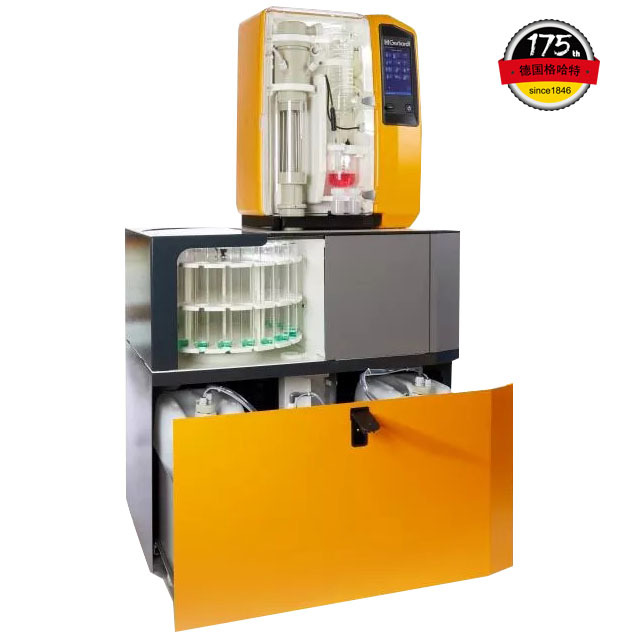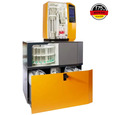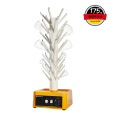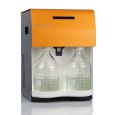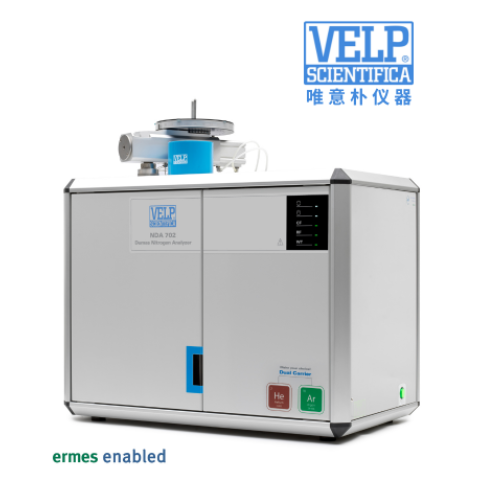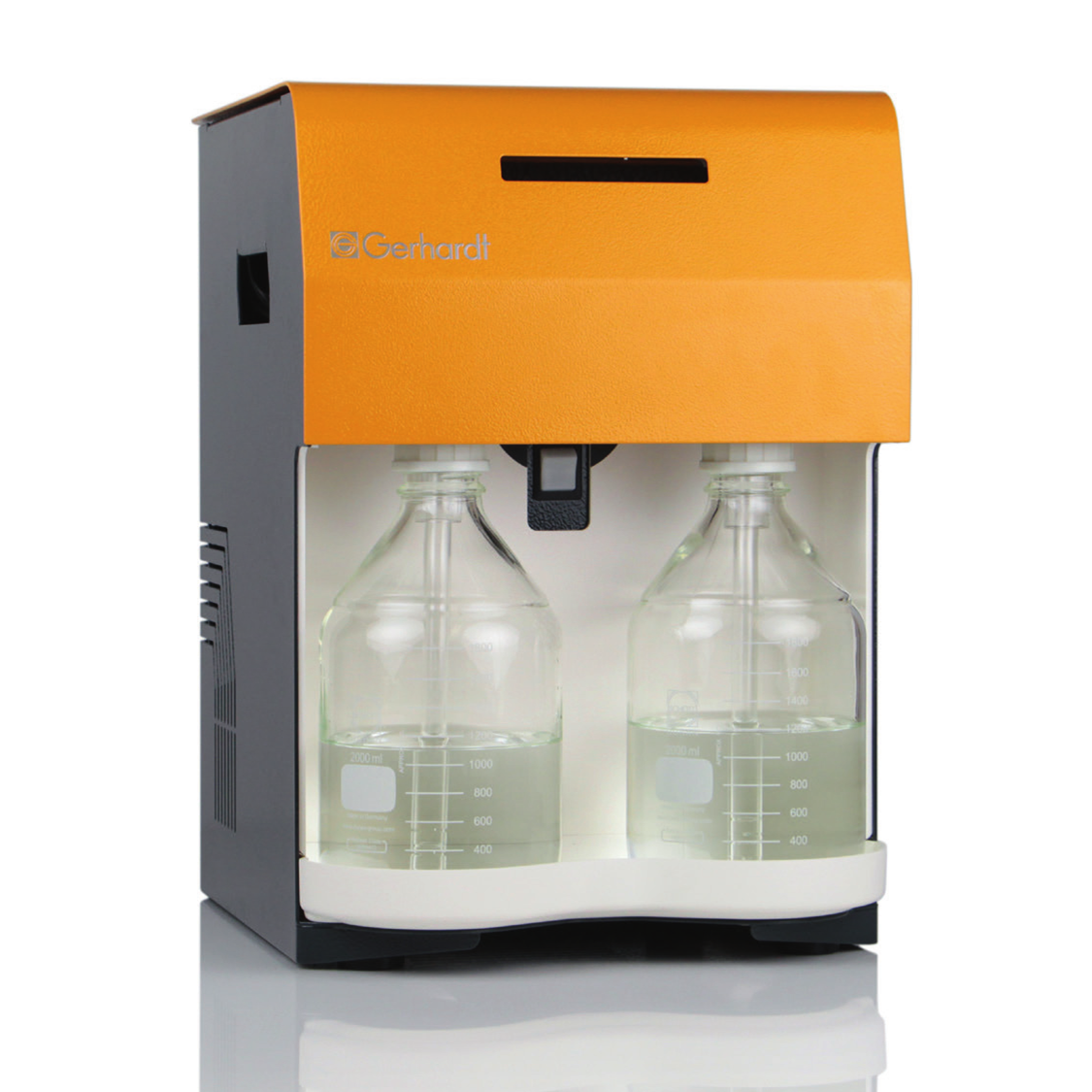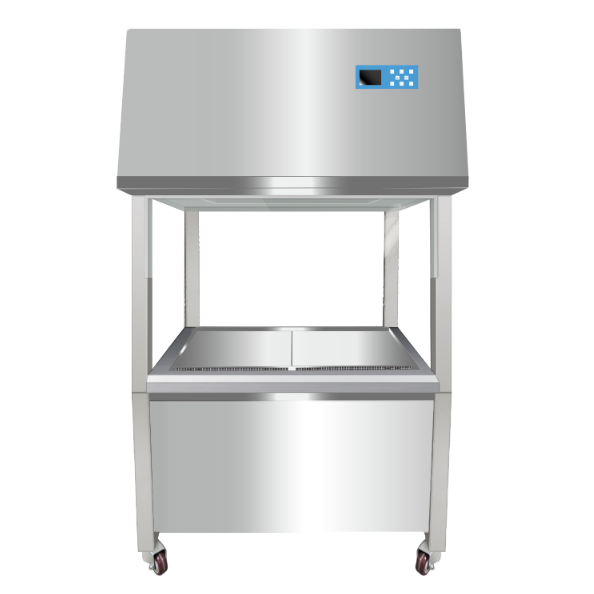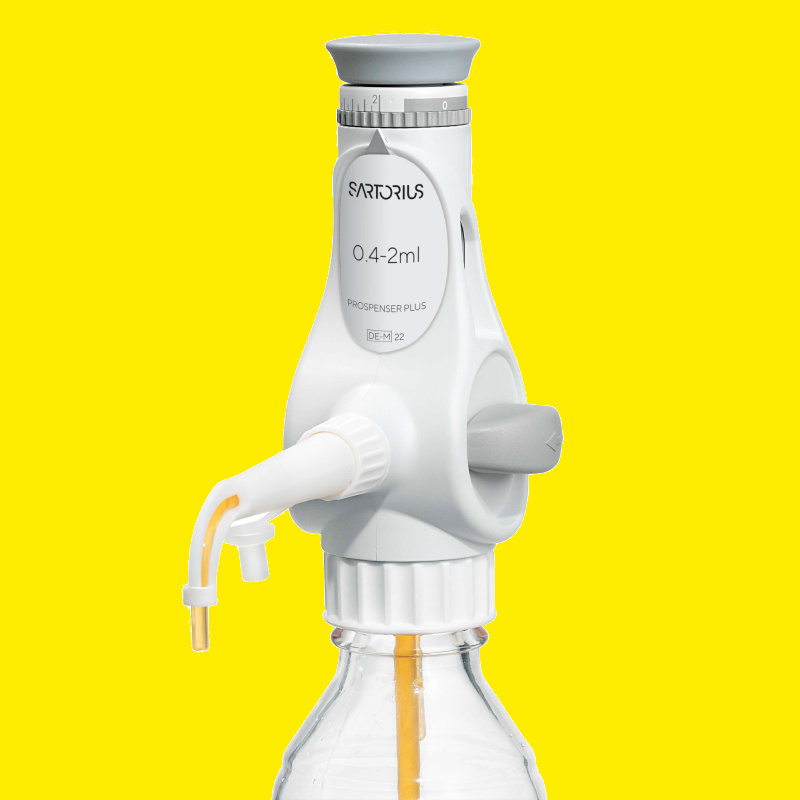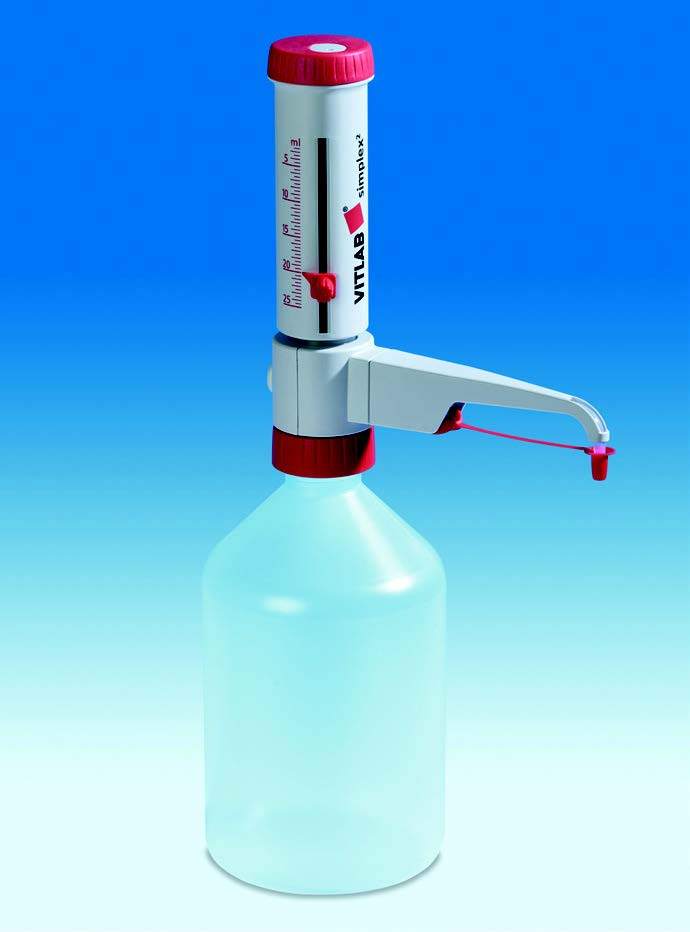方案详情
文
水泥混凝土地板上饲养的断奶前大型约克郡白仔猪的性能Performance of large white Yorkshire piglets reared on cement concrete floor during pre-weaning period
方案详情

水泥混凝土地板上饲养的断奶前大型约克郡白仔猪的性能Performance of large white Yorkshire piglets reared on cement concrete floor during pre-weaning periodThe Pharma Innovation Journal 2022; SP-11(9): 2927-2934 https://www.thepharmajournal.comThe Pharma Innovation Journal ISSN (E): 2277-7695 ISSN (P): 2349-8242 NAAS Rating: 5.23TPI 2022; SP-11(9):2927-2934◎ 2022 TPI Telangana, India Sarat Chandra Gnana Prakash Telangana Veterinary University , Rajendranagar, Hy d erabad, Telangana, India Srinivas Reddy M Corresponding Author: 在水泥混凝土地板上饲养的断奶前大型约克郡白仔猪的性能 Performance of large white Yorkshire piglets reared on cement concrete floor during pre-weaning period Shende GP, Prasad RMV, Sarat Chandra, Gnana Prakash, Nagalakshmi D and Srinivas Reddy M Abstract 24 LWY piglets were selected immediately after birth and were reared on cement concrete floor til l weaning (56 days) to assess the effect of f l ooring system on growth, biometry and physiological parameters. The mean birth weight (kg) and weaning weight (kg) of LWY piglets was 1.15±0.03 and 8.03±0.23. The mean body l ength and height at withers at birth was 22.20±0.51 (cm) and 15.28±0.52(cm). The total gain in heart girth (cm) and hip-width (cm) from birth to weaning was 17.52±0.42 and 5.55±0.23. A linear increase was observed in all biometry measurements from birth to weaning as age advanced which i s a genera l characteristic of growth. The overall mean rectal temperature (102.35±0.05F), respiration rate (55.04±0.46 breaths/min) and pulse rate (96.67±0.67 beats/min.) of piglets were appeared to be within normal physiological range. Keywords: Large white Yorkshire piglets, biometry, physiological responses, cement concrete floor 1. Introduction The challenges faced by t he country in securing food as well as nutritional security for the fast-growing population need an i ntegrated approach i n livestock farming. Pig farming has the potential to provide employment opportunities to seasonal l y employed rural f armers and supplementary income to improve their living standards. Pig has got one of t he highest f eed conversion efficiencies i.e ., t hey produce more l ive weight gain f rom a given weight of f eed than any other class of meat-producing animals except t he broilers. Pigs can utilize a wide variety of feedstuffs viz. grains, forages, damaged feeds, and garbage and convert t hem i nto valuable nutritious meat . Pigs are one of t he most proli f ic breeders with high fecundity and shor t er generation interval. They have high growth potential of reaching market weight at an early age under better management conditions. Flooring type may affect growth performance if the flooring material causes stress to t he animal. Therefore, the ideal bed needs to be hygienic, dry, r esilient, and reasonably temperature resistant. Proper flooring management and design are critical for bet t er h ealth care, longevity, comfort, and increased productivity. A balance must exist between animal comfort and well-being, cleanliness, and feed digestibility and efficiency. So, t here i s a need to explore different materials as floors to ensure the balance between comfort and productivity. As in India much work on effect of flooring systems on performance i n pigs i s not done. I n view of the above, the present study was planned to study the effect of concrete floor on growth performance of L.W. Y. piglets i n the i ntensive system as a part of effect of different flooring systems viz. elevated slatted floor, soi l floor, rubber mat floor on performance of piglets. 2. Materials and Methods The present study was undertaken to f ind out the effect of concrete f loor on growth performance and physiological responses of Large Whi t e Yorkshi r e piglets during pre-weaning period under an intensive system. The experimental procedures and techniques adopted during the course of t he study are detailed in this chapter. 2.1 Location of the study The experiment was conducted at Pig Unit, Livestock Farm Complex (LFC), College of Veterinary Science, Rajendranagar, Hyderabad. 2.2 Environmental conditions Hyderabad i s located i n central Telangana and t he city l i es at 17.366°N lat i tude and 78.476°E longitude in t he Deccan Plateau and rises to an average height of 536 m above t he sea level. Hyderabad has a unique combination of a tropical wet and dry climate that borders on a hot semi-arid climate (Koppen cl i mate classification). During the period of the study, the average maximum temperature recorded was 31.5°C whi l e the average minimum temperature was 21.7℃. 2.3 Selection of experimental animals Two weeks before farrowing, t hree advanced pregnant sows were transferred to the farrowing pen with a creep area. After furrowing, day old 24 Large White Yorkshire piglets of either sex from three litters were selected from the pig unit of LFC of C.V.Sc., Rajendranagar and reared on normal conventional concrete flooring along wi t h t heir mother till weaning.Experiment was carried out for a period of 56 days during the pre-weaning period (May 2020 t o July 2020). 2.4 Housing and management of experimental animals All t he piglets were housed under conventional housing with concrete floor along with their mother provided wi t h a floor space of 9 m2 / sow in the covered shed with asbestos roof.The experimental piglets were ear notched f or proper recording of the data. The needle teeth of the piglets were cut on the birth day. Al l t he piglets were i njected with iron on t he 4t h day and 14th day and vitamin A on the 14th day of t he experiment. Al l the experimental animals were kept under hygienic conditions t hroughout t he experimental period.Healthy surroundings and proper cleanliness was maintained in the experimental sheds. Proper f eeding and watering arrangements were made hygienically. 2.5 Feeding and watering management Experimental piglets during t he pre-weaning period were provided with the creep ration as per ICAR (2013), the composition of the creep ration i s presented in Table 2.1.Creep feed was provided to piglets during t he pre-weaning period once a day ad-libitum i n the creep area f rom the 21st day of age. Leftover of feed, if any, was recorded next day morning at 24 hours intervals throughout the experiment t o calculate the total feed consumed per day. Potable, clean and fresh drinking water was made available to each animal i n separate water troughs t hroughout the experimental period. 2.6 Body weight gain Body weights of piglets were recorded at fortnightly intervals throughout exper i ment a digital electronic plat f orm weighing balance before offering feed and water i n t he morning. Total weight gain was calculated by subtracting final body weight from initial body weight. 2.7 Average daily gain (ADG) The average daily gain was calculated by using the following formula ADG was calculated fortnightly during experimental period. 2.8 Feed intake Feed offered and feed refusal was monitored fortnightly for each li tter during pre-weaning period and f eed i ntake was calculated. Table 1: Ingredient composi t ion of concentrate mixture (kg) Ingredient Creep feed (Pre-Starter ration)(%) Grower ration (%) Body weight (kg) Up to10 10 to 25 Maize 32 34 De-oiled rice bran (DORB) 15 15 Red gram chuni (RGC) 11 19 Groundnut cake (GNC) 39 29 Mineral mixture 2 2 Salt 1 1 CP Supplied*(%) 20.02 18.1 *(ICAR, 2013) 2.9 Biometric Measurements Body measurements were recorded by using a standard measuring tape to the nearest 0.5 centimeters after t he animals were allowed to stand squarely on an even ground. This was performed before offering feed and water i n the morning.The body measurements were recorded as per Gautam et al.(2018) as mentioned below. 2.9.1 Body length (BL): Body length was measured from the top of the head in between t he ears to the base of the t ai l . 2.9.2 Heart girth (HG): Heart girth was measured around t he body just behind t he front legs and over the shoulder area. 2.9.3 Height at wither: Height at wither was measured from the top of the withers to the bottom of the foreleg. 2.9.4 Hip width (HP): Distance f rom t he t uberosity prominence of i l ium bone of one side to the other, across t he rump. 2.10 Crude Protein (CP) A known quantity of the ground samples (appropriate aliquots) were digested usingTurbo t herm (Gerhardt,Germany) with the suitable quantity of concentrated H2SO4 i n the presence of catalytic digestion mixture (CuSO4 and K2SO4in 1:10 ratio). An acid blank was also run along with t he samples for correction of any nitrogen contribution by the acid itself. The nitrogen content of t he sample was estimated by distil li ng i n auto-analyzer (Vapodest, Gerhardt, Germany).The nitrogen content multiplied by the factor 6.25 arrives the CP content of the sample, which was expressed asa percentage on DMB. (AOAC,2005) The data was subjected to analysis of variance (Snedecor and Cochran, 1994) [39] and a comparison of means of different treatment groups was made by Duncan’s mul ti ple range test (Duncan,1955). 3. Results 3.1 Growth Performance 3.1.1 Body Weights The data on fortnight l y body weight gain in LWY piglets is presented in Table 3.1. The mean birth weight (kg) of LWY piglets was 1.15±0.03 which was i ncreased to 8.03±0.23 by the fourth fortnight. The bodyweight of piglets increased as they advanced in age and for t nightly body weight was statist i cally significant (p<0.01) among all fortnights. T he total gain in body weight (kg) f rom birth to weaning was 6.88±0.22. 3.1.2 Average Daily Gain The observed fortnightly Average Daily Gain (ADG) i s presented i n Table 3.2. The observed average daily gain (g)was 96.28±4.19, 88.10±6.48, 122.62±9.57, and 183.78±6.58in the f i rst, second, third, and fourth fortnight respectively.There was a significant di f ference in average daily gain (p<0.01) among different f ortnights. The overall mean average daily gain (g) was 122.69±4.20 during pre-weaning period. 3.1.3 Creep feed intake During t he pre-weaning period creep feed was provided to the piglets from t he second fortnight and data was r ecorded from the second fortnight and presented i n Table 3.3. The recorded creep feed intake (kg) was 0.093±0.00, 0.138±0.01, and 0.261±0.01i i r nthe e second, third and f fourthfortnight respectively. There was a significant difference i n creep feed intake (p<0.01) among di f ferent fortnights. The overall mean feed intake during the pre-weaning period was 0.164±0.00 kg. 3.2 Biometry of piglets during pre-weaning period Piglets have a balanced relat i onship between body weights and biometry. The body measurements included in t he study were body l ength, heart girth, height at withers, and hip-width, during different fortnights. 3.2.1 Body Length The resul t s under the experiment regarding f or t nightly body length (BL ) are presented in Table 3.4 The mean body l ength at birth was 22.20±0.51 (cm) and i ncreased to 30.82±0.17,33.66±0.32, 39.62±0.50, and 45.35±0.47 cm during t he f ir st,second, third, and fourth fortnight respectively. Stati s tical analysi s revealed a signi f icant (p<0.01) difference among mean body l ength at 1birth and between all fortnights throughout the experiment. The overall mean body length (cm) was 34.33±0.26 during t he pre-weaning period. 3.2.2 Height at Withers The data on the fortnightly height at withers is presented in Table 3.5. Mean height at withers (cm) at birth was 15.28±0.522and increased t t t o o 19.50±0.33,22.34±0.35,26.52±0.34, and 30.49±0.25 dur i ng the first, second, third,and fourth fortnight respect i vely. Statist i cal analysis showed a signi f icant (p<0.01) difference in height at withers between all the fortnights and at birth. The overall mean height at withers (cm) was 22.83±0.29 and the total gain observed was 15.21±0.49 from bir t h to a fourth fortnight during the pre-weaning period. 3.2.3 Heart Girth The result regarding fortnightly heart girth is presented i n Table 3.6. The mean heart girth (cm) ranged f rom 26.88±0.23at birth to 44.40±0.48 at the fourth for t night. Statistical analysis revealed a significant (p<0.01) dif f erence between all the fortnightly heart girth. The overall mean hear t girth (cm)was found to be 34.72±0.28 and the total gain in heart girth from birth to weaning was 17.52±0.42 cm. 3.2.4 Hip Width Data on fortnightly hip width during the pre-weaning period is presented i n Table 4.7. The perusal of the r esul t s presented in Table 3.7 pertaining to the fortnightly hip width revealed that the mean hip width (cm) at birth was 5.35±0.13 whereas thesame was6.60±0.077,.77.62±0.08,9.26±0.16, and 10.90±0.20 during the first, second, third, and fourth f ortnight respectively. Statistical lanalysis revealed asignificant difference (p<0.01) in mean hip-width between hip-width at birth and all fortnights. The overall mean hip-width was 7.94±0.09 during pre-weaning age and the total gain in hip-width from birth to weaning age was 5.55±0.23 during the pre-weaning period. Floortype Birth weight (kg) Body weight (kg) Overall mean bodyweight (kg) Total gain in body weight(kg) F1 F2 F3 F4 Concrete 1.15±0.03e 2.49±0.06d 3.73±0.12d 5.46±0.19° 8.03±0.23a 4.17±0.11d 6.88±0.22 N 24 SEM 0.182 P Value 0.000 Means with different superscripts row-wise differ significantly: p<0.01. Table 3: ADG (gm/day ) of L.W.Y. piglets during the p re-weaning period. Floor type Overall mean ADG (gm/day) F1 F2 F3 F4 Concrete 96.28±4.19° 88.10±6.48c 122.62±9.57b 183.78±6.58a 122.69±4.20 N 24 SEM 4.058 P Value 0.000 Means with di f ferent superscripts r ow-wise di f fer signi fi cantly: p<0.01. Table 4: Creep f eed intake (kg/day/head) of L.W.Y. piglets during the pre-weaning per i od. Floor type Creep feed intake (kg/day/head) Overall mean creep feed intake (kg/day/head) F2 F3 F4 Concrete 0.093±0.00d 0.138±0.01° 0.261±0.01a 0.164±0.01 N 24 SEM 0.011 P value 0.000 Means with different superscripts row-wise differ significant l y: p<0.01. Table 5: Body length (cm) of L .W.Y. piglets during t he pre-weaning period. Floor type Body length at birthday Body length (cm) Overall mean bodylength (cm) Total gain in bodylength (cm) F1 F2 F3 F4 Cement concrete 22.20±0.51 30.82±0.17 33.66±0.32 39.62±0.50 45.35±0.47 34.33±0.26 23.16±0.71 N 24 SEM 0.630 P Value 0.000 Means with di f ferent superscript s row-wise di f fer signi f icant l y: p<0.01. Table 6: Height at withers (cm) of L.W.Y. piglets during the pre-weaning period. Floor type Height at withers atbirthday Height at withers (cm) Overall meanheight at withers (cm) Total gain inheight atwithers (cm) F1 F2 F3 F4 Cement concrete 15.28±0.52e 19.50±0.33d 22.34±0.35c 26.52±0.34b 30.49±0.25a 22.83±0.29c 15.21±0.49 N 24 SEM 0.427 P Value 0.000 Means with di f ferent superscript s row-wise differ significant l y: p<0.01. Table 7: Heart girth (cm) of L.W.Y. piglets during t he pre-weaning period. Floortype Heart girth atbirthday Heart girth (cm) Overall mean heartgirth (cm) Total gain in heartgirth (cm) F1 F2 F3 F4 Concrete 26.88±0.23e 29.95±0.28d 33.44±0.32° 38.93±0.48b 44.40±0.48a 34.72±0.28c 17.52±0.42 N 24 SEM 0.636 P Value 0.000 Means with dif f erent superscripts row-wise differ significantly: p<0.01. Table 8: Hip width (cm) of L.W.Y. piglets during t he pre-weaning period. Floor type Hip width on birthday Hip width (cm) Overall mean hipwidth (cm) Total gain in hipwidth (cm) F1 F2 F3 F4 Cement concrete 5.35±0.13e 6.60±0.07d 7.62±0.08c 9.26±0.16b 10.90±0.20a 7.94±0.09 5.55±0.23 N 24 SEM 0.154 P Value 0.000 3.3 Physiological parameters of piglets during Ppre-weaning period Physiological parameters i ncluded during pre-weaning period were recta l t emperature, respiration rate, a nd pulse rate. 3.3.1 Rectal Temperature Data on fortnightly recta l t emperature during the pre-weaning period is presented i n Table 3.8. From the perusal of t he results presented in Table 4.8revealed a mean rectal temperature (F) of 101.76+0.12, 102.10±0.12,102.40±0.10,102.69±0.09 and 102.83±0.18 at birth, first, second, third and fourth fortnights respectively. Statistical analysis revealed the highest rectal temperature during the fourth fortnight but did not differ significant l y with the first, second, and t hird fortnight. Mean rectal temperature at bi r th was lowest and comparable with f irst fortnight but significantly (p<0.01)different from second, third, fourth, and overall r ectal temperature. The overal l mean rectal temperature of piglets was 102.35±0.05 during pre-weaning age. 3.3.2 Respiration Rate Data on fortnightly respiration rate during the pre-weaning period is presented in Table 3.9. As presented in Table 4.9 the mean respiration ratee (breaths/min) was 59.21±0.65,55.04±0.46, 50.79±0.82, 46.38±0.73, and 41.21±1.18 at birth,first, second, third, and fourth f ortnight r espectively during the pre-weaning period. There was a continuous decrease i n mean respiration rate from birth to weaning during t he pre-weaning period. The statistical analysis discovered a signi f icant (p<0.01) di f ference in mean respiration rate at birth and all t he fortnights. The overall mean respiration rate in piglets was 55.04±0.46 during the pre-weaning period. 3.3.3 Pulse Rate Data on pulse rate in piglet s during the pre-weaning period is presented i n Table 3.10. Mean pulse rate (beats/min) was highest at birth i .e., 115.17±2.40 and then decreased to 96.67±0.67, 96.00±1.88, 94.33±2.28, and 92.00±1.87 during the f irst, second, third, and fourth fortnight. Mean pulse r ate at birth showed a statistical l y signi f icant (p<0.01) difference with all the fortnights. The overall mean pulse r ate was 93.63±1.38. Table 9: Rectal temperature ("F) of L.W.Y. piglets during t he pre-weaning period Floor type At birth day Rectal temperature (°F) Overall mean rectaltemperature (°F) F1 F2 F3 F4 Cement concrete 101.76±0.12° 102.10±0.12bc 102.40±0.10ab 102.69±0.09a 102.83±0.18a 102.35±0.05 N 24 SEM 0.056 P value 0.000 Means with different superscripts row wise di f fer signi f icant l y: p<0.01. Table 10: Respiration rate (breaths/min) of L.W.Y. piglets during the pre-weaning period. Floor type Respiration rateat birth day Respiration rate (breaths/min) Overall mean respiration rate(breaths/min) F1 F2 F3 F4 Concrete 59.21±0.65a 55.04±0.46b 50.79±0.82° 46.38±0.73d 41.21±1.18 55.04±0.46 N 24 SEM 0.587 P value 0.000 Means with different superscript s row-wise differ significantly: p<0.01. Table 11: Pulse rate (beats/min) of L.W.Y. piglets during the pre-weaning period Floor type Pulse rate at birth day Pulse rate (beats/min) Overall mean pulserate (beats/min) F1 F2 F3 F4 Cement concrete 115.17±2.40a 96.67±0.67b 96.00±1.88b 94.33±2.28b 92.00±1.87b 96.67±0.67 N 24 SEM 0.956 P value 0.000 Means with different superscripts row-wise differ significant l y: p<0.01. 4. Discussion 4.1 Growth performance 4.1.1 Body Weights Body weight gain is an important i ndicator in deciding t he performance and health status of any animal. The mean body weight at birth (1.15±0.03 kg) of LWY piglets was increased to 8.03±0.23 kg by the fourth fortnight at weaning. The bodyweight of piglets increased as they advanced i n age and size. The fortnight l y body weight was statist i cally signif i cant (p<0.01) among al l fortnights. The total gain i n body weight (kg) from birth to weaning was 6.88±0.22. The value for birth weight found i n the present study is i n concurrence with t he findings of Cauveri et al. (2009) 1101,Kaushik et al. (2013) [18], Pandurangareddy et al. (2013) [29],Jaishankar et al. (2015) [i6], Gowrimanokari et al. (2018)[15],Ravindra Kumar et al. (2018) [35] and Ashitha et al. (2019)[6]In contrary to the present findings, higher values were reported by Arango et al. (2006) [, Raseel et al. (2016) [34],and Archana et al. (2018) 15]. Kumar et al. (2019) [21] have reported higher values for birth weight whereas, Rokde e t al.(2013)[36], Debnath et al. (2015) [11], and Sandhu et al. (2018)[7] reported a lower value for birth weight. The results for weaning weight in t he present study are supported by the results of Palve et al. (2000) [28], Cauveri et al . (2009)[10], Ramesh and Sivakumar (2009) [32] Rokde et al.(2013)[361, Devendran et al. (2015) [12], Archana et al. (2018)B], and Kumar et al. (2019) [21]. Higher weaning weight in LWY piglets compared to present study were reported by Narayanan et al. (2008) [24], Kaushik et al. (2013) [18]Pandurangreddy et al. (2013) [29], Jaishankar et al. (2015)[16],Raseel et al. (2016) [34], Ravindra Kumar et al. (2018) [35],Sandhu et al.(2018) B37], and Ashi t ha et al. (2019)[6 4.1.2 Average Daily Gain The overal l mean average daily gain (g) was 122.69±4.20during pre-weaning period. Similar findings were observed by Plave et al. (2000) [28], Jayashree and Shivakumar (2013)[17,Ravindra kumar et al. (2018) [35], Ashitha et al. (2019) [6] and Keyho et al. (2019) [19] The present findings were not in agreement with Prasad et al.(2006) [31], Kaushik et al. (2013) [18], Ramesh et al. (2014)[33],Jaishankar et al. (2015) [16] and Sandhu et al. (2018) [37] who reported higher values for pre-weaning average daily gain compared to t he findings of the present study. This might be due to the i ssue of variation in milk yield of the sows. The pre-weaning body weights are also influenced by the mothering abi li ty of the sows. 4.1.3 Creep Feed Intake The recorded average daily creep feed i ntake (kg/piglet) was 0.093±0.00, 0.138±0.01, and 0.261±0.01 during the second,third and fourth fortnight respect i vely. There was a significant difference in creep feed i ntake (p<0.01) among different fortnights. The overall mean daily feed i ntake (kg/piglet ) was 0.164±0.00 kg during the pre-weaning period. The present findings were not in agreement with Fraser et al.(1994) [13], Bruininx et al. (2002) [8], Bruininx et al. (2004) [],Sulabo et al. (2010) [40], Sulabo et al. (2010a) [41], Toi (2017)[46] who reported higher values for daily creep feed i ntake i n piglets during pre-weaning period. Lower l evel of creep feed intake was reported by Pajor et al. (1991) [27], Tissopi et al.(2020) [43], Kumar et al. (2012) [22], Middelkoop et al. (2019)[23] There was a great variation i n creep feed i ntake of the piglets during pre-weaning period and this could be due to many factors affect i ng the creep feed i ntake i n piglets like birth weight, milk yield and milk composition of the sow, diseases and quality and palatability of t he creep f eed. 4.2 Biometry of piglets during different fortnights pre-weaning 4.2.1 Body Length The mean body length at birth was 22.20±0.51 (cm) and increased t to o 30.82±0.17,33.66±0.32, 39.62±0.50, and 45.35±0.47 during the first, second, third, and fourth fortnight respectively.Statisticalanalysis r revealed a significant (p<0.01) difference among mean body length at birth and between al l fortnights throughout the experiment. The overall mean body l ength (cm) was 34.33±0.26 during the pre-weaning period. The i ncrease in t he body length during the study period i ndicated ageneral feature ir respective of flooring system The present findings are in accordance with Oluwole et al.(2014) [26] and Birteeb et al. (2015) , but in disagreement with Alenyorege et al . (2013)③, Talwar (2014) [42], Tissopi et al. (2019)[44] and Khargharia et al. (2014)[201 4.2.2 Height at Withers Mean height at withers (cm) at birth was 15.28+0.52 and increased to 19.50±0.33,22.34±0.35, 26.52±0.34, and 30.49±0.25 during the f irst, second, thi r d, and fourth fortnight respectively. Statistical 1analysiss s l howed a signi f icant (p<0.01) difference in height at withers between all the fortnights and at birth. The overall mean height at withers (cm) was 22.83±0.29 and the total gain observed was 15.21±0.49 from birth to a fourth fortnight during the pre-weaning period. The present findings are i n accordance with the findings of Tissopi et al. (2019) [44] Birteeb et al. (2015) [7] and i n disagreement with Oluwole et al. (2014) [26] who reported higher height at withers and Khargharia et al. (2014) [20] have reported lower values for height at withers. 4.2.3 Heart Girth The mean heart gir t h (cm) at birth observed was 26.88±0.23which was increased to 29.95±0.28, 33.44±0.32, 38.93±0.48,and 44.40±0.48 dur i ng the first , second, third, and fourth fortnight respectively. Statistical analysi i s s revealed a signi f icant (p<0.01) difference in mean fortnight l y heart girth between heart girth at birth and all four fortnights. The overall mean heart girth (cm) was 34.72±0.28 and t he t otal gain i n heart girth f rom bi r th to weaning was 17.52±0.42 during p re-weaning age. The present findings were similar with t he findings of Adeola et al. (2013) [2], Alenyorege et al. (2013) B], Oluwole et al.(2014) [26], Birteeb et al. (2015) , and Tissopi et al. (2019)[44]. Khargharia et al. (2014) [20] and Talwar (2014) [42]reported lower values for heart girth, hence dissimilar to the present findings. 4.2.4 Hip Width Mean hip width (cm) at birth recorded was 5.35±0.13 and increased to 6.60±0.07,7.62±0.08, 9.26±0.16, and 10.90±0.20during the first, second, third,, and fourth f fortnight respectively. Statistical analysis revealed difference (p<0.01) i n mean hip-width between hip-width at birth and all fortnights. The overall mean hip-width was 7.94±0.09 during pre-weaning age and the total gain i n hip-width from birth to weaning age was 5.55±0.23 during the pre-weaning period. The present findings were dissimilar with Adeola et al.(2013)[2] who reported higher values for hip width. In this study al l the biometric measurements indicated t hat during the period of growth all the parameters shown a l inear progression. 4.3 Physiological parameters during different fortnights pre-weaning 4.3.1 Rectal Temperature Mean rectal temperature recorded was ("F) of 101.76±0.12,102.10±0.12,102.40±0.10,102.69±0.09 and 102.83±0.18 at birth , f irst, second, third and fourth fortnights respectively.Statistical analysis revealed the highest rectal t emperature during the fourth fortnight but did not differ significantly with the first, second, and t hird fortnight. Mean rectal temperature at birth was lowest and comparable wi t h first fortnight but signi f icantly (p<0.01) di f ferent from second, third, fourth fortnight, and overall rectal temperature. T he overall mean rectal temperature of piglets was 102.35±0.05 during pre-weaning age. Present findings are similar to the findings of Peter et al.(2002) [30], Sipos et al. (2013) [38], and Nuntapaitoon et al.(2018) [25] who have reported increase in rectal temperature of piglets as age advanced. 4.3.2 Respiration Rate Mean respi r ation rate (breaths/min) observed was 59.21±0.65,55.04±0.46,50.79±0.82, 46.38±0.73, and 41.21±1.18 at birth,first, second, third, and fourth fortnight r espectively during the pre-weaning period. There was a continuous decrease in mean respiration rate from birth to weaning during t he p re-weani g period. The statistical analysis discovered a signi f icant (p<0.01) di f ference i n mean respiration rate at birth and all the fortnights and mean respiration rate was simi l ar during the second and t hird fortnight. The overall mean respiration rate in piglets was 55.04±0.46 during the pre-weaning period. These results are supported by t he result of Sipos et al. (2013)[38] who have reported decrease in respiration rate as age advanced. 4.3.3 Pulse Rate Mean pulse rate (beats/min) observed was highest at birt h i.e.,115.17±2.40 and then decreased to 96.67±0.67, 96.00±1.88,94.33±2.28, and 92.00±1.87 dur i ng the first, second, third,and fourth fortnight . Mean pulse rate at birth showed a statist i cally significant(p<0.01) di f ference with all t he fortnights. The mean pulse rate at the thi r d and fourth f ortnight was not statist i cal l y significant. The overall mean pulse rate was 93.63±1.38 and was comparable with the second fortnight during the pre-weaning period. Sipos et al. (2013) [38] recorded decrease in pulse rate of piglets from birth to weaning and these findings were in agreement with the present results, but the pulse rate recorded by Sipos et al. (2013) [38] was higher t han t he present f indings.This might be due to variability i n environmental conditions. The results wi t h regards to respiration rate and pulse rate were a l most i n consistent with l i terature cited attributing to the f act that as piglets grow in age there wi l l be decline i n the specif i c rate whereas rectal temperature rise slightly as age advanced during pre-weaning period. 5. Conclusion The results of the present study indicated t hat t he concrete floor did not cause any stress as reflected by normal average daily gain, creep feed intake, biometric measurements and physiological responses. 6. Acknowledgements Authors are thankful to t he University Officers of P. V.Narsimha Rao Telangana Veterinary Universi t y, Hyderabad,Telangana, India for according permission to carry out the research work. 7. References 1. AOAC. Official methods of analysis. 18 Ed. Association of Official Analytical Chemist, Benjamin Franklin Station, Washington, DC; c2005. 2. Adeola AC, Oseni SO, Omitogun OG. Morphological characterizat i on of i ndigenous and crossbred pigs i n rural and peri-urban areas of southwestern Nigeria. Journal of Animal Sciences. 2013;3:30-235. 3. Alenyorege B , Addy F, Abgolosu AA. Linear body measurements as predictors of live weight of t he large white pig in Northern Ghana. Ghanaian Journal of Animal Science,2013, 7. 4. Arango J, Misztal I , Tsuruta S, Culbertson M, Holl J W and Herring W. Genetic study of individual pre-weaning mortal i ty and birth weight in large white piglets using threshold-linear models. Livestock Science.2006;101:208-218. 5. Archana K, Selvam S, Sivakumar T, Serma Saravana Pandian A, Balasubramanyam D, Mohamed Safiul l ah A.Effects of Season, Sex and Period of Farrowing on Growth Performance of Large White Yorkshire Pigs.International Journal of Pure and Applied Bioscience 2018;6(5):900-903. 6. Ashitha K, Balusami C, John Abraham, Senthilmurugan S, Sakkariya Ibrahim NP. Effect of brooding systems on growth performance in l arge white yorkshire piglets. The Pharma Innovation Journal. 2019;8(9):195-198. 7. Birteeb PT, Tetteh SO,Salifu AS. Growth performance and weight estimat i on of Large White piglets weaned at different ages. Research && Reviews S ::Journal of Veterinary Science and Technology. 2015;4:15-23. 8. Bruininx EMAM, Binnendijk GP, Van der Peet-Schwering CMC, Schrama JW, Den Hartog LA, Everts H, et al. Effect of creep feed consumption on individual feed intake characteristics and performance of group-housedweanl i ng pigs. Journalof anima a l l science.2002;80:1413-1418. 9. Bruininx EMAM, Schellingerhout AB, Binnendijk GP,Van der Peet-Schwering CMC, Schrama JW, Den Hartog LA, et al. Individual l y assessed creep food consumption by suck l ed piglets: Inf l uence on post-weaning f ood i ntake characteristics and indicators of gut structure and hind-gut fermentation. Animal Science. 2004;78:67-75. 10. Cauveri D, Sivakumar T, Devendran P. Pre-weaning body weights in large white Yorkshire crosses. Indian Journal of Animal Research. 2009;43:130-132. 11. Debnath BC, De A. Ravikanth K. Evaluation of herbal maternal care product for t i mely conception, optimized fetal growth and survival rate in large white Yorkshire Sow. The Pharma Innovation. 2015;4:93. 12. Devendran P, Gopinathan A, Murugan M, Cauveri D.Pre-weaning body weights of Large White Yorkshire (50%) pig crosses over generations. I ndian Journal of Animal Research. 2015;49:284-287. 13. Fraser D, Pajor EA, Feddes JJR. The relationship between creep feeding behavior of piglets and adaptation to weaning: effect of diet quality. Canadian Journal of Animal Science. 1994;74:1-6. 14. Gautam VN, Shraddha Shrivastava, Lakhani GP, Baghel RPS, Kuldeep Narayan Tripathi. Effect of castration on growth performance and carcass quality in crossbred pigs. Journal of Entomology andZoology Studies.2018;6:1573-1576. 15. Gowrimanokari KV, Thiagarajan R, Venkataramanan R,Gopi H. Effect of i nbreeding on pre-weaning and sow performance traits i n Large White Yorkshire pigs. Indian Journal of Animal Research. 2018;53:997-1001. 16. Jaishankar S, Murugan M, Gopi H. Comparative pre- weaning performance of 75% l arge white Yorkshire crossbred pigs of f i f th and sixth fil i al 1 generation.International Journal of Science, Environment and Technology. 2015;4:1236-1239. 17. Jayashree PC, Sivakumar T. Influence of early weaning on productive and reproductive performance i n large white yorkshire pigs. Tami l nadu Journal of Veterinary and Animal Sciences. 2013;9:207-212. 18. Kaushik P, Handique PJ, Rahman F Habibur, Das Anubrata, Kr Das Anil, Bhuyan Gagan. Pre-weaning growth performance of pure and crossbred pigs under organized farm condition in Assam. International Journal of Engineering Science I nvention. 2013;2:10-12. 19. Keyho K, Sabin George, Anil KS, Sasidharan M, Dipu MT, Sunanda C, et al. Effect of weaning age and pre-starter diet on the performance of large white Yorkshire piglets. The Pharma Innovat i on Journal. 2019;8:606-608. 20. Khargharia G, Zaman G, Laskar S, Das B, Aziz A,Roychoudhury R, et al. Phenotypic characterization and performance studies of Niang Megha and Doom pigs of North eastern India. Asian Academic Research Journal of Multidisciplinary. 2014;1:2319-2801. 21. Kumar KSV, Balasubramanyam D, Venkataramanan R,Gopi H. Production and sow performance of l andrace pigs under north eastern agro climatic conditions of Tamil Nadu. Journal of Entomology and Zoology Studies. 2019;7:1201-1203. 22. Kumar SG, Mukesh S, Triveni D, Patel M, Mandal AB,Sanjay K, et al. Influence of indigenous galactogogue on performance of SOWS and d F piglets a and related economics. Indian Journal of Animal Sciences.2012;82:1051-1054. 23. Middelkoop A, Costermans N, Kemp B, Bolhuis JE.Feed intake of the sow and playful creep feeding of piglets i nfluence piglet behaviour and performance before and after weaning. Scientific reports. 2019;9:1-13. 24. Narayanan R, Ronald BSM, Baegan S, Prabakaran R.Effect of age at weaning on growth performance of l arge whi t e yorkshire. Tamilnadu Journal of Veterinary and Animal Sciences. 2008;4:237-239. 25. Nuntapaitoon M, Muns R, Tummaruk P. Newborn traits associated with pre-weaning growth and survival i n piglets. Asian-Australas Journal of Animal Science.2018;31:237-244. 26. Oluwole OO, Tiamiyu AK, Olorungbounmi TO, Oladele-Bukola MO, Akintoye NA. Pre-weaning growth traits i n Nigeriann i ndigenous pig c crossbreds. Agr i cultural Sciences. 2014;5:891-896. 27. Pajor EA, Fraser D, Kramer DL. Consumpt i on of solid food by suckling pigs: individual variation and relation to veight gain. Appliec Animal Behav i our Science.1991;32:139-155. 28. Palve S, Maitra DN, Pyne AK, Roy SK, Majumder SC.Ef f ect of season on l itter t raits of Large White Yorkshire pigs inWest EBengal. IIndianVeterinary Journal.2000;77:640-642. 29. Pandurangareddy P, Gnana Prakash M, Punya Kumari B,Suresh J, Alok Bharthi . Genetic analysis of pre-weaning body weights in crossbred pigs. Indian Journal of Animal Research. 2013;47:70-74. 30. Peter Jackson GG, Peter Cockcroft D. Normal Physiological Values. Clinical Examination of Farm Animals by Blackwell Science Ltd.; c2002. p.301. 31. Prasad RMV,Jayalaxmi P,P KKrishna Reddy GV. Performance of large white Yorkshire pigs in Andhra Pradesh. Indian Veterinary Journal. 2006;83:454-455. 32. Ramesh S, Sivakumar T. Comparative performance of landrace and l arge white yorkshire pigs under tropical maritime monsoon climate. Journal of Veterinary and Animal Science. 2009;40:42-46. 33. Ramesh V, Edwin SC, Murugan M, Vasanthakumar S.Effectt of different feedingsystems on growth performance and carcass t raits of growing and finishing pigs. Indian Journal of F i eld Veterinarians. 2014;9:60-64. 34.Raseel K, Kotresh Prasad, Sunanda C. A study of seasonal variations on productive performance of cross bred pigs in high range regions of Wayanad. International Journal of Science and Nature. 2016;7:387-389. 35. Ravindra Kumar, Mandal B. Kumari N, Patel N.Performance of Different Genetic Groups of Pigs Maintained Under AICRP on Pig. International Journal of CurrentMicrobiology and Appliedd S Sciences.2018;7:822-826. 36. Rokde NK, T hakur MS, Parmar SNS. Comparat i ve performance among di f ferent genetic groups of l arge white yorkshire crossbred pigs. Journal of Animal Research. 2013;3:153-159. 37. Sandhu KS, Malik DS, Chandrahas, Sahoo SP, Saini AL.Effect of weight and age based split weaning on growth performances and welfare of Large White Yorkshire piglets. Indian J Journal of Animal Research.2018;52:1087-1090. 38.Sipos W,。Wiener rS. Entenfellnerr F,Sipos S.Physiological changes of r ectal temperature, p ulse rate and respiratory rate of pigs at di f ferent ages including the critical peripartal period. Veterinary Medicine Austria.2013;100:96. 39. Snedecor GW, Cochran WG. Statistical methods. 8th edi t ion. Affiliated dEast. West tPress, New Delhi.1994;13:1467-1473. 40. Sulabo RC , Jacela JY, Tokach MD, Drit z SS, Goodband RD, DeRouchey JM, et al. Effects of lactation feed i ntake and creep feeding on sow and piglet performance. Journal of Animal Science. 2010;88:3145-3153. 41.Sulabo RC, Tokach MD, Dritz SS, Goodband RD,DeRouchey JM, Nelssen JL. Effects of varying creep feeding duration on the proportion of pigs consuming creep feed and neonatal pig performance. Journal of Animal Science. 2010;88:3154-3162. 42. T alwar P. Effect of feeding organic and inorganic sources of additional zinc on growth performance of young piglets. M.V.Sc. Thesis. Veterinary College Bangalore,(Karnataka Veterinary, Animal and Fisheries Sciences Universi t y, Bidar), Bangalore, Karnataka, I ndia, 2014. 43.T i ssopi M, Bordoloi J P, Hussain J, Ahmed HF. Effect of feeding probiotics and milk powder supplemented creep ration on the growth performance and ef f iciency of f eed utilization in pre-weaning piglets. I ndian Journal of Animal Nutrition. 2020;37:185-190. 44.Tissopi M, Bordoloi JP, Saharia J, Kro R. A Study of Body Weight and I Its Relation with Linear Body Measurements in Piglets Fed Different Feed Formulation. Agricul t ural Science Digest; c2019. p. 39. 45.Toi SM. Effect of Feeding Sol i d State Fermented Ration on the Performance of Hampshire Piglets. M.V.Sc.Thesis.Col l ege of Veterinary Science, (Assam Agricul t uralUniversity), Guwahati-781022, Assam,India; c2017.
确定

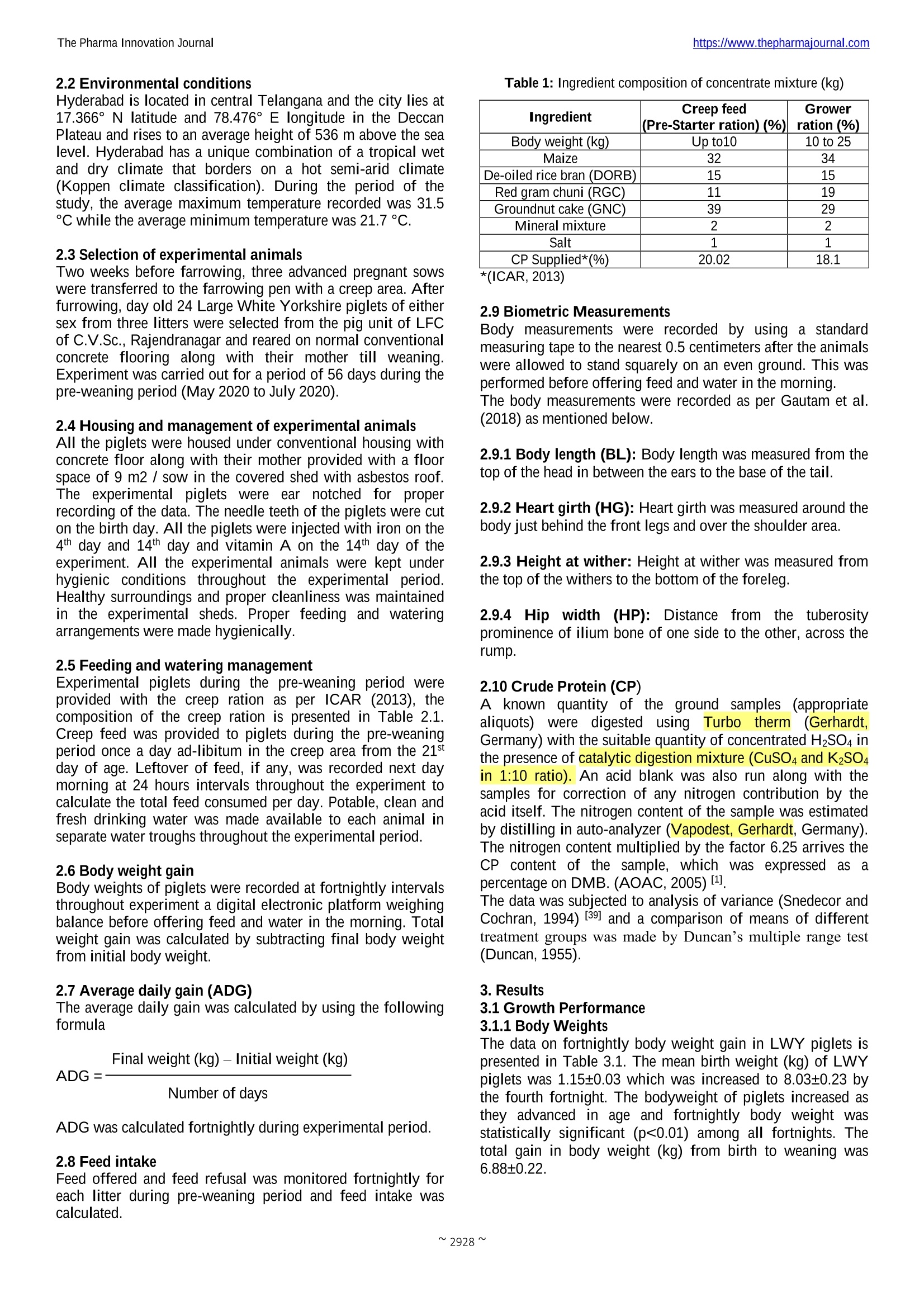
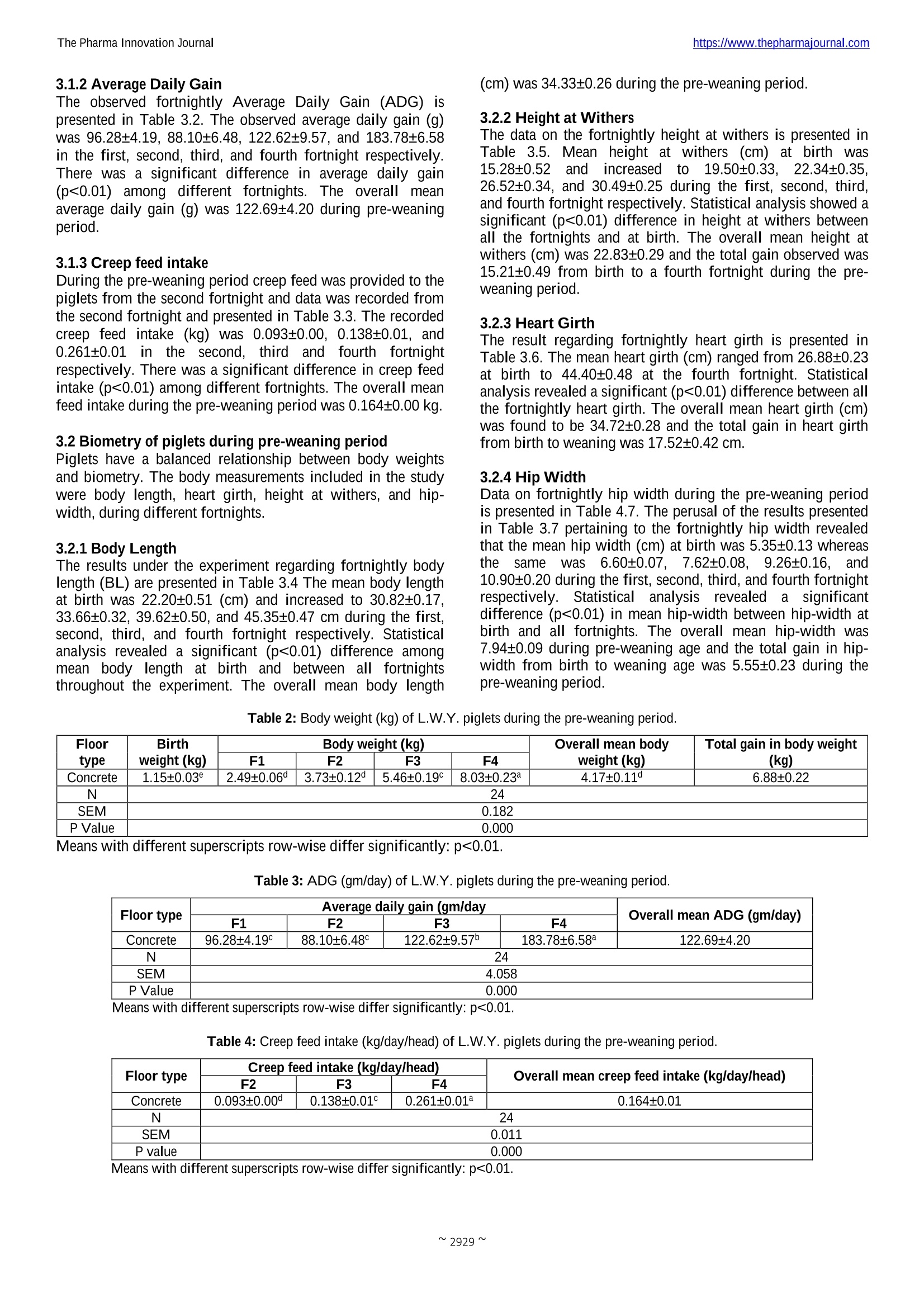
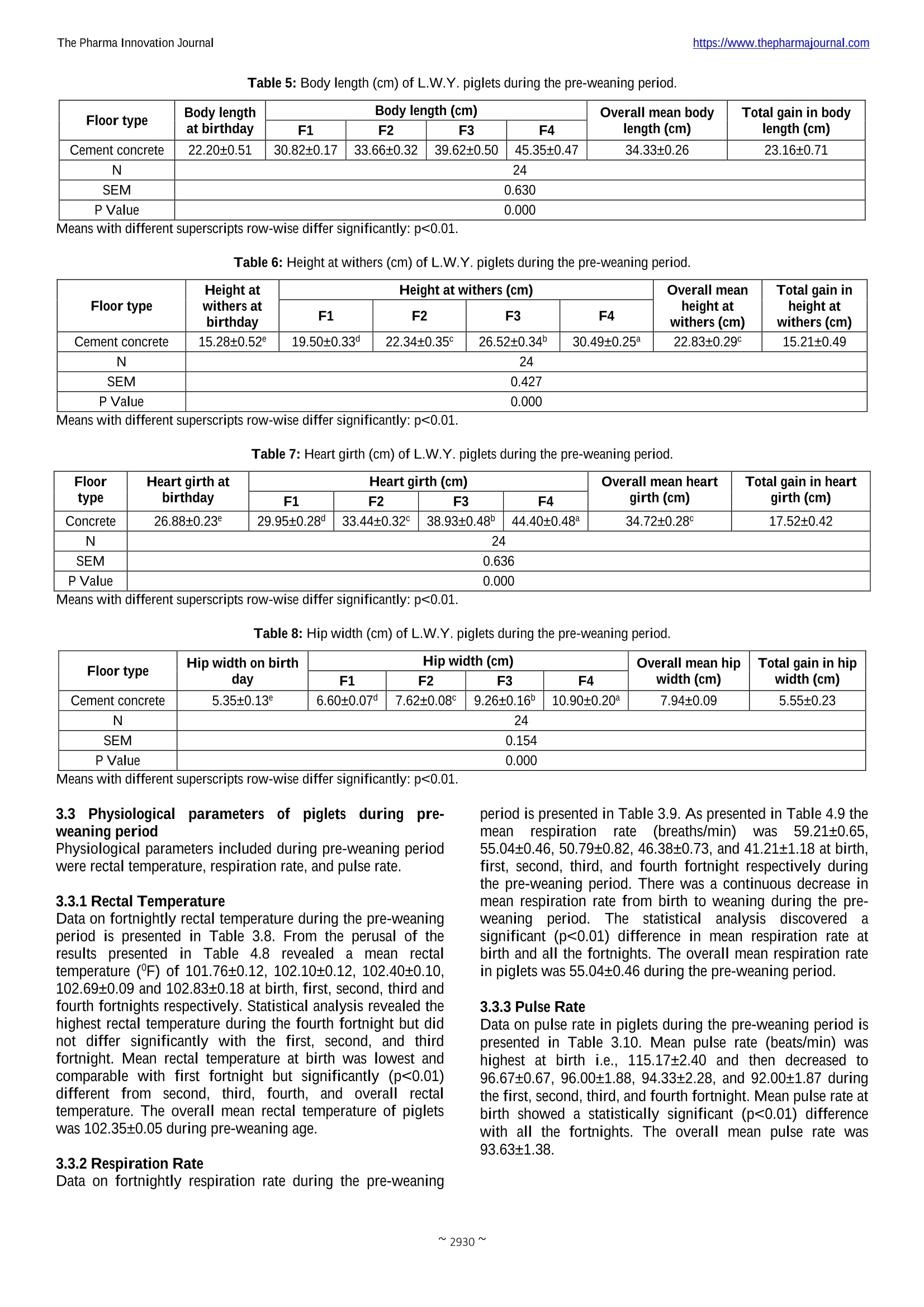
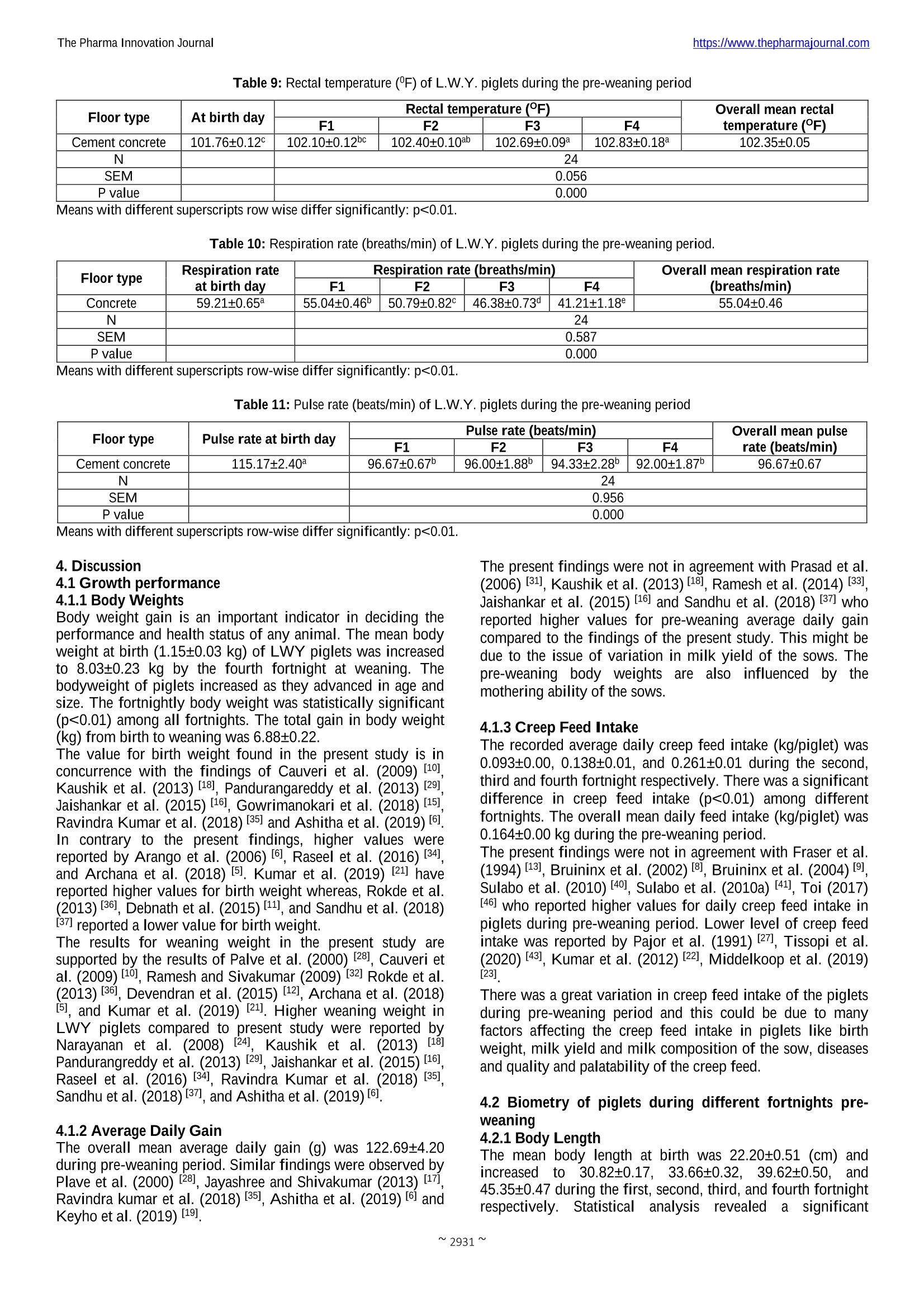
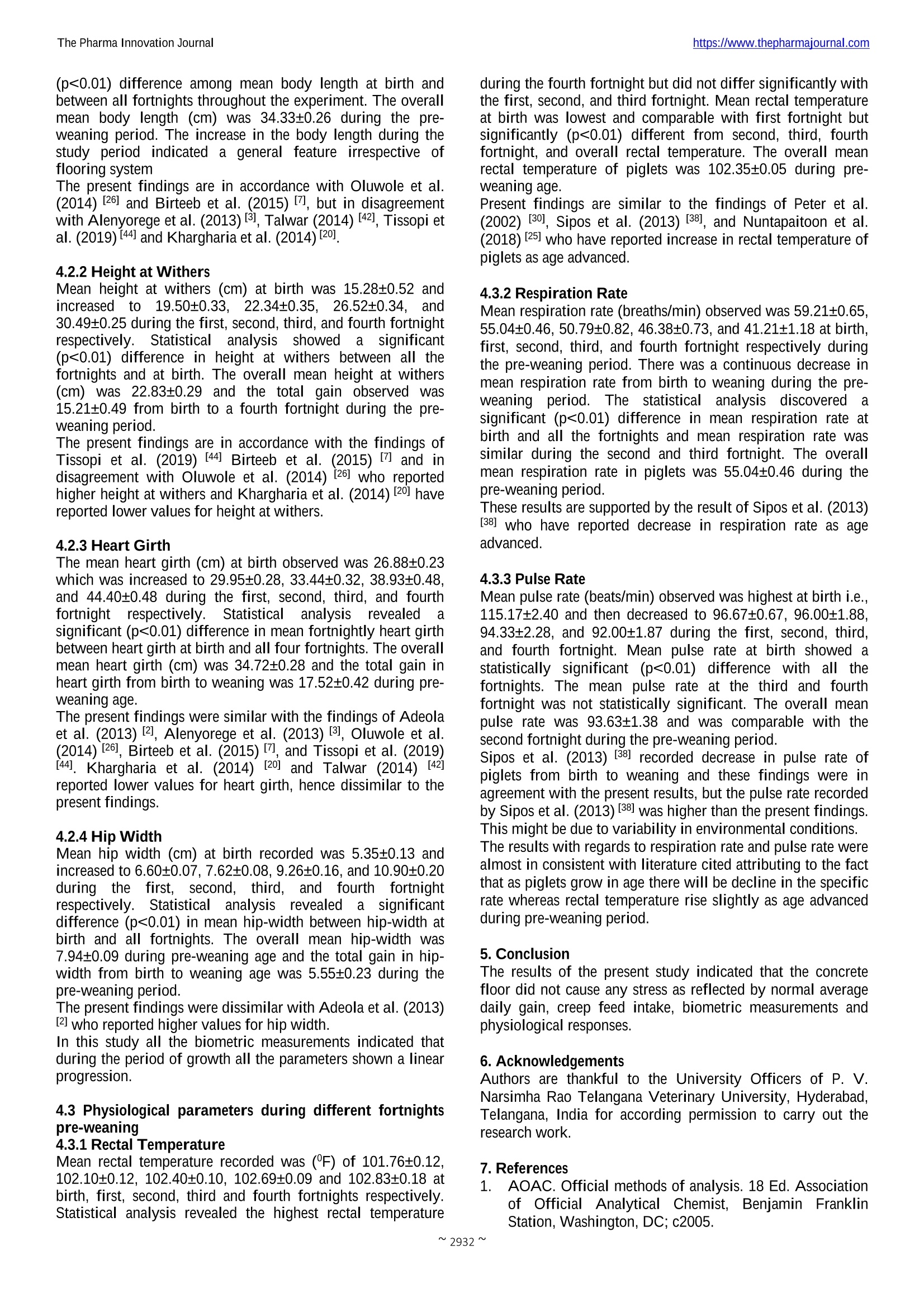
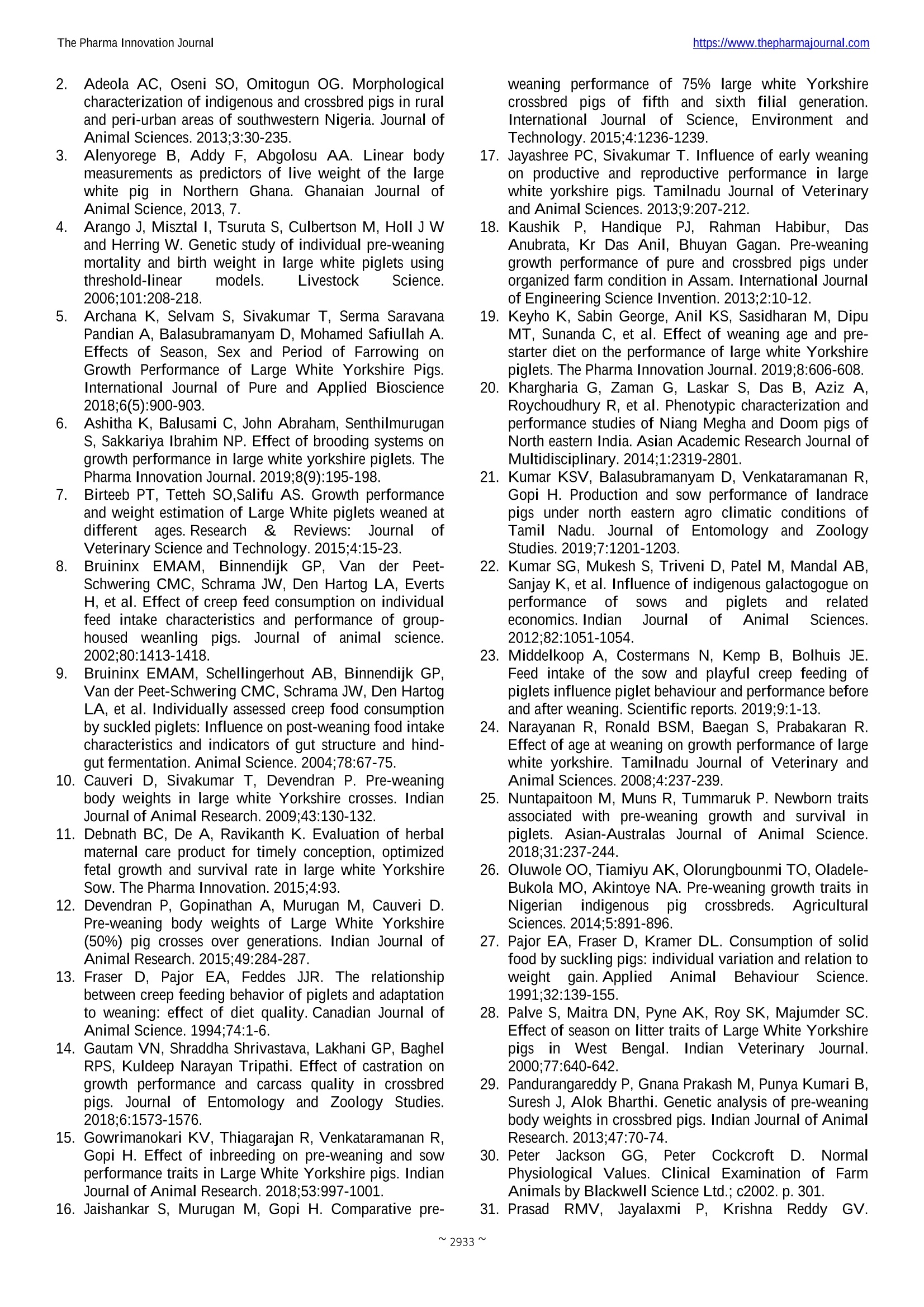

还剩6页未读,是否继续阅读?
中国格哈特为您提供《大型约克郡白仔猪肉蛋白质含量的检测》,该方案主要用于畜禽肉及副产品中营养成分检测,参考标准《GB 5009.5 食品安全国家标准 食品中蛋白质的测定》,《大型约克郡白仔猪肉蛋白质含量的检测》用到的仪器有格哈特带自动进样器凯氏定氮仪VAP500C、格哈特快速干燥仪STL56、格哈特红外加热消解快速消化系统TTs125、格哈特维克松废气实验室废物处理系统涤气VS、德国加液器MM、凯氏定氮催化片
相关方案
更多
该厂商其他方案
更多

